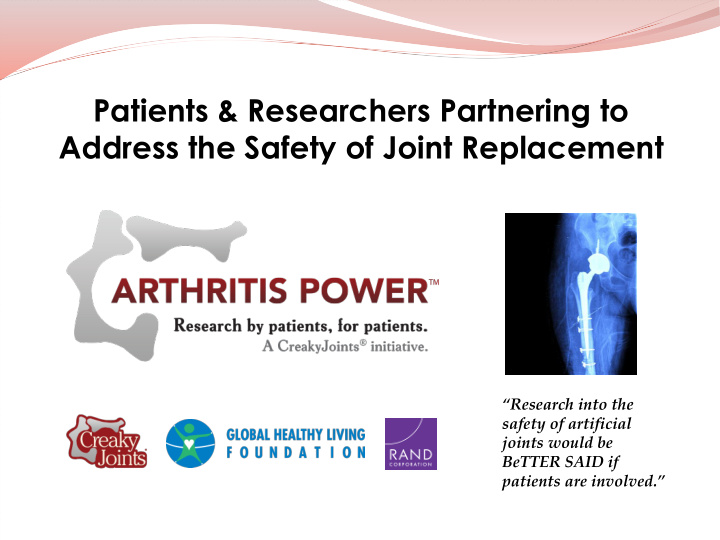



Patients & Researchers Partnering to Address the Safety of Joint Replacement “Research into the safety of artificial joints would be BeTTER SAID if patients are involved.”
Agenda Bringing STakeholders Together for Engagement in Research for the Selection of Arthroplasty Implant Devices (BeTTER SAID) Who’s out there? Welcome – 5 mins What do we know? Registration Results – 5 mins What can we do? Research Roles for Patients – 45 mins What’s the next step? Wrap-Up – 5 mins
Welcome! Ben Nowell Shilpa Venkatachalam Tom Concannon Global Healthy Living Foundation Global Healthy Living Foundation RAND Corporation CreakyJoints CreakyJoints This project is funded through a Patient-Centered Outcomes Research Institute (PCORI) Eugene Washington PCORI Engagement Award (2228-GHLF).
Consent Information you provide will be used for research purposes only. Global Healthy Living Foundation, CreakyJoints and RAND will keep your identity confidential and will not attribute comments to specific individuals. Please do not repeat anything you hear in a way that is attributable to other people. The discussion will be audio recorded to create de-identified transcripts. The original audio recordings will be destroyed.
Welcome! Thank you for joining the discussion. Where are you from? What joint replacement(s) have you had or are thinking of having? What do you do?
Agreements Take care of yourself & ask for what you need Ask questions (some medical lingo may be unfamiliar) Step up, step back (draw out others’ ideas) Agree to disagree Acknowledge everyone’s experience is different “One mic” (please mute phone when not speaking) Others?
REGISTRATION SURVEY RESULTS Among people who have had hip and/or knee replacement surgery… Percentage who were informed about specific implant 63% device Percentage who saw or held the device 34% Percentage who learned about the risks and benefits 55% associated with surgery Percentage who learned about other devices 18%
REGISTRATION SURVEY RESULTS Among people who are candidates or are considering having surgery… Percentage who want to be informed about the specific 88% implant device Percentage who want to hold or see a model of their 71% device Percentage interested to learn about the risks and benefits 88% associated with surgery Percentage who want to learn about other existing devices 88% on the market
REGISTRATION SURVEY RESULTS Questions patients asked before surgery: How do I decide what kind of implant device to use? What material is the implant device made of? How big is [it]? What happens if this device fails? How long will it last? Will it need to be replaced eventually? What will be my range of motion? Can it cause infection to other joints? Questions patients wished they’d asked before surgery: Are there different types of implants to chose from? What metal is the implant device made from? What happens if my body rejects the implant? How long is the average life span of the implant? Will my knees ever feel like normal again? Will the implant device work for patients with RA? I have been diagnosed with lupus. Do I have any additional risk factors?
What matters to you as a patient could become an important research question Think about your own joint replacement experience… What decisions do you care most about?
Patients can be involved in every phase Phase 1: ‘Before’ Identifying topics, prioritizing research questions, designing a study, developing study eligibility Phase 2: ‘During’ Developing surveys and other tools, helping recruit participants, assisting with data analysis, serving as a patient representative Phase 3: ‘After’ Planning dissemination activities, identifying partner organizations, identifying forums to share findings, bringing together patients & stakeholders to discuss
Could mean involvement in any or all phases of research Leads to integration of research results Includes patients, family members, by the patient & Patients as broader caregivers PARTNERS healthcare community IN RESEARCH Helps make Encompasses research more organizations patient-centered, & stakeholders useful, & trustworthy
Patients play different roles in research Co-Leader • A patient who is a co-principal investigator has ultimate accountability and control over the project. Co-leaders are part of an organization responsible for proposing the research, designing the study, and meeting all reporting requirements of the project. Staff • A patient who serves as a consultant / staff member works on design and development of research tools and participates in interpreting and disseminating findings. Advisor • A patient with expertise offers advice and feedback to researchers in the design and implementation of the research.
You can be part of the research process Think about your own experience… What motivates you to be part of research about joint replacement?
Thank you for participating in this discussion! You will receive a follow-up email In-person roundtables in the coming year: New York City Boston Chicago Please contact us with questions or suggestions at bnowell@ghlf.org or svenky@ghlf.org or call us at the Global Healthy Living Foundation at (845) 348-0400.
Recommend
More recommend